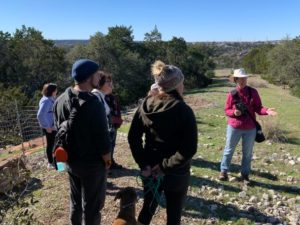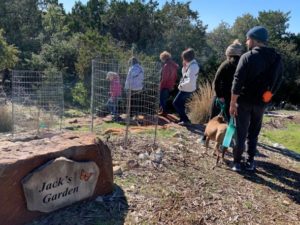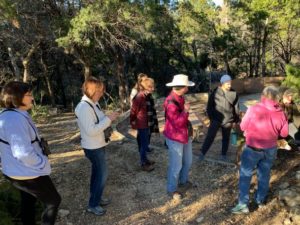On Saturday, February 11, nine of us took a 90 minute stroll through the TLLC woods, looking at the landscape from a bird’s point of view, with a focus on the value of native plants.



Jane Tillman, an active member of the Travis Audubon Society, has been teaching a Birds of Central Texas class at TLLC for several years for the local non-profit Lifetime Learning Institute. She noticed a sign about our first bird walk in the woods and offered a follow-up class in appreciation for being able to use our facilities these past years. Having been down in our woods several times over the winter, I didn’t think there would be a lot for her to see, but was I ever wrong about that!
Jane pointed out to us over 13 different trees and plants that provide important food and shelter, and identified 10 different species of birds visiting our woods, including two white winged doves, a Cooper’s hawk, a Carolina chickadee, a black crested titmouse (actually three of them), two ruby crowned kinglets, four golden crowned kinglets, a Bewick’s wren, a lesser goldfinch, two yellow-rumped warblers, and two northern cardinals. A highlight of our walk was a prolonged observation of three golden-crowned kinglets foraging in a blooming agarita. For more information on each of the birds identified on this walk, CLICK HERE.
Jane pointed out five kinds of trees, including the Texas persimmon, which is popular with birds, the ashe juniper (commonly called cedar trees), which are very important to birds for shelter, insects and berries, a Lindheimer’s silk tassel and live oaks and shin oaks. She emphasized that all oak species are critical to songbirds’ survival as they host many moth and butterfly species. And she encouraged us to “leave the leaves” when they fall as they provide shelter for butterfly larvae (read more about this HERE).
Perennials spotted by Jane included basket grass, cedar sage (whose “wonderful early red bloom stalk provides nectar for migrating hummingbirds in early spring”), twist-leaf yucca, agarita (which produce yellow blooms that provide nectar, and red berries which are readily eaten by several species), Lindheimer’s senna, also known as puppy dog ears (which blooms yellow and is a host plant for sulphur butterflies, as well as a nectar plant for other butterflies), Texas lantana (a good nectar plant for butterflies and hummingbirds), Lindheimer’s muhly, aka big muhly (an excellent grass that provides nest material and seeds and is a host plant for several skipper butterfly species), and silverleaf nightshade which is a nectar source and highly drought tolerant.
Jane’s knowledge and enthusiasm is an inspiration to those of us that want to steward our TLLC grounds and our own yards, providing inviting habitats for birds and butterflies and in so doing, care for creation.
Learn more about this and other opportunities by joining our Care of Creation Team meetings on the 4th Saturday of each month at 1:30pm. See our calendar for details.

